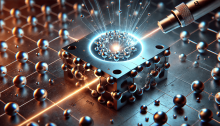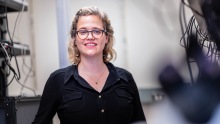An international team including UBC physicist Walter Hardy, TRIUMF researchers and collaborators from across Canada have trapped antimatter, marking the end to a ten-year race to isolate the enigmatic particles.
"Studying anti-hydrogen--an anti-proton and an-anti-electron--to the same precision as we can study hydrogen has been a dream project for some time," says Hardy, an expert in cuprate superconductors and professor with the Department of Physics and Astronomy.
"The difficulty is that anti-matter is produced at high energies, and bringing the two components together to form the anti-atoms, and then getting them to sit still long enough to do the required measurements, is extremely difficult."
The results of the discovery were published last week in the journal Nature.
“This is a major discovery. It could enable experiments that result in dramatic changes to the current view of fundamental physics or in confirmation of what we already know now,” says Rob Thompson, associate professor at the University of Calgary and co-investigator in the ALPHA collaboration, one of two teams competing to gain a better understanding of antimatter and our universe.
ALPHA and the Harvard-led ATRAP have been conducting experiments in close quarters at CERN, the world's largest particle physics lab, located in the suburbs of Geneva, Switzerland. CERN is the only laboratory in the world with the proper equipment where this research can be carried out.
The goal of the competition involves trapping and storing the simplest of all antimatter atoms, antihydrogen, with the purpose of studying it. Hydrogen is the lightest and most abundant chemical element, constituting roughly 75 per cent of the universe's elemental mass.
“We know a lot about antimatter, but very little about antimatter. We assume there was as much antimatter created in the Big Bang as matter. There are many questions. Where is the antimatter? Where did it go? And why does it appear that there is more matter than antimatter?” says Makoto Fujiwara, a research scientist at TRIUMF, Canada's national laboratory for particle and nuclear physics.
When hydrogen and antihydrogen get too close, they destroy each other in a kind of explosion, leaving behind the energy which made them. The challenge is cooling the atoms off to 272 degrees below zero, so they slow down, can be caught, and stored.
“With trapping established, UBC’s and SFU’s expertise in precision microwave spectroscopy becomes fairly central to the efforts to compare hydrogen to anti-hydrogen,” notes Hardy.
Nature
www.nature.com
Musqueam First Nation land acknowledegement
We honour xwməθkwəy̓ əm (Musqueam) on whose ancestral, unceded territory UBC Vancouver is situated. UBC Science is committed to building meaningful relationships with Indigenous peoples so we can advance Reconciliation and ensure traditional ways of knowing enrich our teaching and research.
Learn more: Musqueam First Nation
Faculty of Science
Office of the Dean, Earth Sciences Building2178–2207 Main Mall
Vancouver, BC Canada
V6T 1Z4


